Pieces of Paper: Cards and Certificates and Their Role in the Recent Past
- June 27th, 2019
- by specialcollections
- in Exhibits, General
“Welcome to the party, we’re all just papers in the wind.” From “Run, Run, Run,” by Jo Jo Gunne, 1972. [https://www.youtube.com/watch?v=lS7pOaEEOTs]
Several decades into the digital revolution, it is clear that digital devices have had an enormous impact upon the routines of literacy. This effect is every bit as profound as that brought about by the print revolution of the fifteenth and sixteenth centuries. Moreover, the digital universe is arguably much broader than the universe of moveable type. After all, the latter, in simplistic terms, was only a superior way to deal with a medium—parchment/paper—that had been around for millennia. In both cases, the “revolution” involved enhancements in the production, dissemination, and storage of information. But power over information has always meant power plain and simple for the persons in charge of society.
With that in mind, let us consider that persons of rank have had, for more than a millennium, access to documents attesting to their property, status, or worth. Consider the Anglo Saxon concept of “bookland,” which involved royal land grants by means of charters or diplomas, deposited for safety among the records of a monastery or abbey. Moving forward to the early modern world, well-connected travelers regularly carried with them letters of introduction—the ancestors of the recommendations (paper or electronic) eagerly sought by today’s applicants for jobs or college admissions. By the middle of the nineteenth century, the need for documentary endorsement had touched the lives of people who were in no sense exalted. For example, a slave in the American south was required to carry a pass signed by his master in order to set foot beyond the master’s property. Ironically, in the last stringent days of the Confederacy, southern white folks had to carry a stamped pass in order to take railroad journeys; such was the effect of wartime bureaucracy.
Soon after the turn of the last century, several forces came together in the United States—industrialization, immigration and population growth, urban planning and ever more far reaching bureaucracies—to produce a society whose members were defined, increasingly, by their paper documents. A standardized system of birth certificates was in place in the United States by about 1900.[1] By the time children born in that year were well-grown, they needed documentation, identity cards, or printed licenses to live their lives. These pieces of paper determined how an individual could function as a citizen. It was necessary, for example, to present a voter registration certificate at the polls. Likewise, most states required persons wishing to live in legally married bliss to secure a marriage license. Speaking of ubiquitous documents, operators of motor vehicles were commonly required to carry driver’s licenses while operating cars or trucks. Paper money had been common in this country since the time of the American Revolution, but by the early twentieth century, the “personal check” had become the most convenient means of paying ordinary debts.[2]
As this generation approached the age of high school they confronted a world at war. Some of the young men were drafted into America’s World War I armed forces—a path that carried with it an imposing battery of records and identity cards. The young men and women who went to college received student ID cards; those who completed college earned diplomas and membership cards from alumni associations. Graduates who wished to practice law or medicine displayed their diplomas on office walls next to licenses issued by professional organizations or state certifying boards.
Just as these “pieces of paper” confirmed what we were qualified to do, they also governed where we were allowed to go. Travel on such forms of commercial transportation as ships, railroads, airplanes and buses was available only to those who held printed tickets. To anyone who has ridden a passenger train, Cary Grant’s ability (in North by Northwest) to travel without a ticket from New York to Chicago is one of his more impressive achievements. Attendance at many important events (weddings, graduations, recitals) required a printed invitation. The right to attend an even larger number of events—movies, plays, concerts, operas, sporting competitions, conventions—required tickets for which one had to pay.
Several personal identifiers are still with us in paper forms; these include drivers’ licenses, framed diplomas, and certificates of various kinds. Paper invitations and tickets of the types described above, likewise, have so far survived the digital onslaught, as have passports—that most official form of identification. Most likely, though, all will sooner or later go the way of the humble grocery store coupon, which is still available in paper but is more commonly displayed on the screens of shoppers’ Smart Phones.
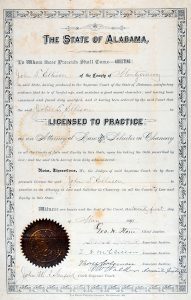
Our Postmodern world is clearly caught up in a time of transition; documentary changes are no doubt only a small part of what is to come. St. Augustine of Hippo, writing a few years after the 410 sack of Rome by Alaric the Visigoth, knew that his world was at a point of crisis; yet he remained cautiously optimistic, thanks to his religious faith and a certain ingrained faith in the permanence of the Empire. In fact his Roman world was soon overwhelmed by multiple crises, but churchmen in the coming centuries were able, somehow, to salvage much of the remains of Classical antiquity. Archivists, collectors, and rare book librarians today are saving what they can (yes, often in digital form) of the vast paper trail of modernity.
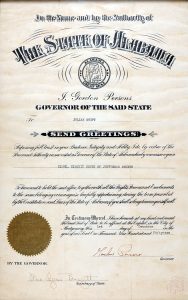
Most of the accompanying images are from the author’s collection of paper documents. The exhibit begins with two items of professional status, both law-related. First is a certificate, dated May 21, 1891, licensing John T. Ellison to practice law in Alabama. Ellison was listed as a resident of Montgomery County, though he would go on to a successful career as a lawyer and public servant in Bibb County.[3] His certificate was signed by all of the then-current members of the Alabama Supreme Court, beginning with George W. Stone,[4] a jurist much-celebrated in his time. Next is a certificate issued by Alabama governor Gordon Persons, dated December 1, 1952, appointing Julian Swift as clerk of Jefferson County’s circuit court.[5]
The next category presents two documents that were vitally important for civic life in the early twentieth-century south” voter registration certificates. The first, dated May 6, 1902, is a “Life Certificate of Registration” issued to one D. Pierson of Precinct 8 of Reform, a town in Pickens County.
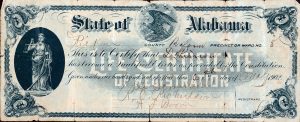
Little is known about Pierson, except that he was one of the relatively small number of voters who registered under the “Temporary” plan of the 1901 Constitution—a document intended to disfranchise nearly all of the state’s black voters and many of the white voters who had recently opposed the Democratic Party.
Life certificates were issued to selected individuals, many of whom qualified to vote through the plan’s “fighting grandfather” clause. Under this provision the adult male descendants of Confederate soldiers could register to vote. The section likewise allowed the registrars to enroll “All persons who are of good character and who understand the duties and obligations of citizenship under a republican form of government.” [6]
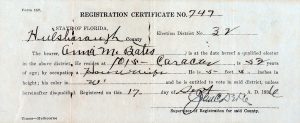
Our second voter registration certificate is that of Anna M. Bates, of Hillsborough County, Florida, issued on September 17, 1936. Her address on the certificate is “1015 Caracas,” probably in Tampa. Six years earlier, according to Census records, she was 46 years old, living in Tampa with her husband, R.M. Bates, age 50, and an aunt May Townsend, age 77. When asked for their occupation, each had replied with one word: “poultry.” The census-taker also noted that Anna Bates and May Townshend had been born in New York, in each case to parents born in New York, while R.M. Bates had been born in Florida to parents born in Massachusetts (his mother) and Maine (his father). Such was the geographical mobility of the early 20th century’s working classes (1930 U.S. Census). Such, too, was the determination of first-generation southern women voters, who understood all too well that the right to vote was both precious and precarious. Look closely at Anna Bates’ certificate, and you’ll see that at nearly every point of identification—residence, height, and color, for instance—her data is entered after the masculine pronoun “he.” The expectation was that voters would be male, and the registrar didn’t bother to correct the form with “she.”[7]
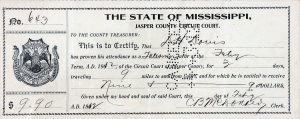
A related if more ephemeral document is a certificate declaring that D.H. Davis had “proven his attendance as a Talesman Juror” at the February 1912 term of Circuit Court in Jasper County, Mississippi.[8] A talesman is “a person summoned to act as a juror from among the by-standers in the court.”[9] Davis (1879-1962) was a fairly obscure person, and one might easily suppose that he was a mere courthouse hanger-on, scrounging jury duty in exchange for a few days’ wages; after all, the fee for his services ($9.90) was no small sum at the time. Some searching through Jasper County census records, however, made it almost certain that Davis was a landowning farmer—the sort of man who might take a week off in February, when agricultural duties were at their lightest, to go see the bustle and pomp that accompanied a Circuit Court in the Deep South.[10] And in fact Mississippi law at this time allowed for the appointment of as many as seven talesmen, essentially alternate jurors, from the regular venire; these men would be sworn in and would observe the proceedings until the regular juries retired for deliberation.[11]
Now we turn to a varied succession of commonplace documents.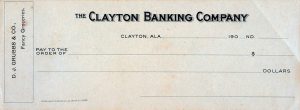 The first is an unused check of the Clayton Banking Company of Clayton, Alabama, dated to the decade of the 1900s. Had it been filled out, it would have been drawn to the account of “D.H. Grubbs & Co., Fancy Groceries.” Grubbs & Co. no doubt advertised in the newspapers of Barbour County; in the fiscal year 1906-1907 the company had furnished goods to the state—to the value of five dollars.[12]
The first is an unused check of the Clayton Banking Company of Clayton, Alabama, dated to the decade of the 1900s. Had it been filled out, it would have been drawn to the account of “D.H. Grubbs & Co., Fancy Groceries.” Grubbs & Co. no doubt advertised in the newspapers of Barbour County; in the fiscal year 1906-1907 the company had furnished goods to the state—to the value of five dollars.[12]
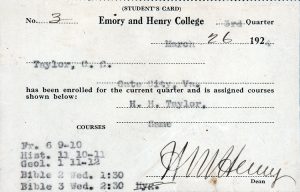
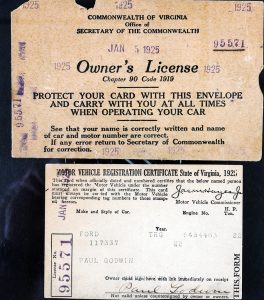
Following Mssrs. Grubbs’ blank check, we examine a collection of documents from Virginia. First, from the southwestern corner of the Old Dominion, is an Emory and Henry College student ID card issued to C.C. Taylor in March 1924. It states that Taylor was from nearby Gate City, Virginia, and includes his schedule of classes for the third quarter of that year. Courses in French, History, and Geology consumed Taylor’s mornings from 9:00 to 12:00, and on Wednesday afternoons he attended Bible 2 and Bible 3. Emory and Henry is a Methodist liberal arts college located in a mountainous, mineral-rich environment; so Taylor’s courses were nothing out of the ordinary.[13] Next is an automobile “Owner’s License” (No. 95571) issued on January 5, 1925, to Paul Godwin for the operation of his Ford. Godwin most likely came from Smithfield in Isle of Wight County (numerous mountains and several rivers removed from Emory and Henry). With the license came an envelope, which instructed him in all-caps to “PROTECT YOUR CARD WITH THIS ENVELOPE AND CARRY IT WITH YOU AT ALL TIMES WHEN OPERATING YOUR CAR.” A World War I veteran, he was no doubt accustomed to the bullying ways of bureaucracy.[14]
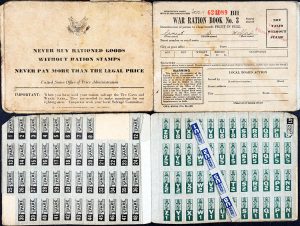
Thanks to a loan, we are able to exhibit an unusual survival, several U.S. ration-books from World War II. The purchase of certain foods, such as “sugar, meat, cooking oil and canned goods,” was rationed, as were transportation-related materials and fuel. This was done under the authority of the federal Office of Price Administration, by means of the ration books it issued to citizens.[15] These were books of detachable ration stamps; one of which was to be handed to the merchant from whom each rationed item was purchased. The booklets containing these particular “pieces of paper” were issued to Elsie M Waldrop, William F. Waldrop, Ernest D. Wofford, and Willie E. Sullivan.[16]
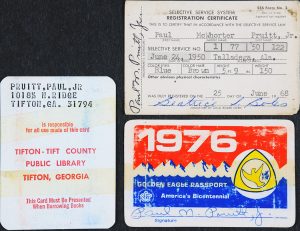
Finally, we consider a number of small cards issued to the author or to members of his family in the third and fourth quarters of the twentieth century. First, a draft card dated to June 1968, an example of a notorious[17] document issued to all males upon their reaching the age of eighteen. The lucky recipients of these cards were required to carry them, a small reminder that the Cold War (in its then-current form, the Vietnam conflict) was never very far away. Second, a Tifton-Tift County (Georgia) Public Library Card issued early in 1974. This card is made of a very paper-like plastic; as such it is a tribute to the advanced thinking of the South-of-Macon librarians of the period. Third, a Golden Eagle Passport purchased in Virginia in 1976. With this laminated card, one could gain admission to any national park or monument to witness the many spectacles that marked our bicentennial celebrations. Finally, we view Juliet Bare Pruitt’s 1983 membership card in the Talladega County Historical Association. At the time, this organization was an active and well-established body. 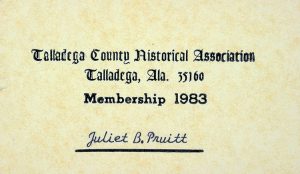 Its members gave presentations at the society’s regularly scheduled meetings; then they could read about them in the society’s newsletter, published by its long-time editor Vern Scott.[18]
Its members gave presentations at the society’s regularly scheduled meetings; then they could read about them in the society’s newsletter, published by its long-time editor Vern Scott.[18]
Thus ends our tour of a few of the types of “paper” that were once so omnipresent. In this post, we have concentrated on personal documents: not newspapers, phone books, Sears & Roebuck catalogs, or printed books. Most of the cards and certificates discussed above were not exactly ephemeral; yet all of them “expired” at some point in time, certainly with the lives of their owners. After that point they were no longer valid; they could not be reissued or renewed; they assumed a status that was at best archival. It will be interesting to see how future generations deal with issues of validity, permanence, and preservation. The electronic documents that will present themselves to future archivists, after all, are only marginally present in the material world.
PMP
[1] Wikipedia article “Birth Certificate,” https://en.wikipedia.org/wiki/Birth_certificate. See note 3 to this article, citing H.L. Brumberg, D. Dozor, and S.G. Golombek, “History of the Birth Certificate: From Inception to the Future of Electronic Data,” Journal of Perinatology, 32: 407–411 (June 2012).
[2] See for example, Percy Bysshe Shelley Peters, Commercial Law with Illustrative Examples and Legal Forms (Cincinnati: South-Western Publishing Company, 1922), 82-87.
[3] It seems likely that the John T. Ellison of this certificate is the same man featured—as diarist, local historian, and chairman of the Bibb County Board of Education—in Rhoda Coleman Ellison’s Bibb County: The First Hundred Years (University, Alabama: University of Alabama Press, 1984), 208, 286 n. 39, 290 n. 31.
[4] See William H. Brantley, Chief Justice Stone of Alabama (Birmingham: Birmingham Publishing Company, 1943).
[5] Swift would hold this office, apparently, until 1975 at least. See Swift v. Esdale, 306 Southern Reporter 2d 268 (1975).
[6] For the Temporary Plan, in operation from 1901-1903, see Alabama 1901 Constitution, Art. 8, §180. For the 1901 Constitution as an agent of disfranchisement, see Malcolm C. McMillan, Constitutional Development in Alabama, 1798-1901: A Study in Politics, the Negro, and Sectionalism (1955; Spartanburg, SC: Reprint Company, 1978), 249-359, passim. See also the Litera Scripta post of December 9, 2016, “Alabama’s 1901 Constitution: Instrument of Power.”
[7] Judged by its physical appearance Anna Bates’ certificate greatly resembles that of Jessie Gillis Parish, which we featured in David Alsobrook’s Litera Scripta post of February 20, 2017.
[8] The certificate was issued by C.B. McDonald, clerk of the Circuit Court. See Dunbar Rowland, Official and Statistical Register of the State of Mississippi (Nashville: Brandon Printing Company, 1912), 3: 474
[9] Black’s Law Dictionary 3rd, 1701.
[10] A Find-a-Grave search turned up the dates given above, for the Jasper County grave of Darling Harvey Davis; see https://www.findagrave.com/memorial/27919861/darling-harvey-davis. Davis was evidently reluctant to tell census takers his real name. In the 1920 census he is listed as Harvey D. Davis, a 40-year old “general” farmer and employer whose wife Tinnie was three years older than he. Forty years earlier, Darling Harvey had been listed as the fifth child of James H. Davis and Eley (or Elcy) Davis, who lived on their farm in Jasper County. James H. Davis was born in Alabama, and Harvey D. Davis stated that his father was born in Alabama, increasing the likelihood that H.D. and D.H. were the same person. See U.S. Population Census, 1920, Mississippi, Jasper County, Northeast District, Sheet 3-A; and U.S. Census of Inhabitants, 1880, Mississippi, Jasper County, 15th District, Beat No. 2, p. 46. Apart from census confusion over his identity, D.H Davis’ comes to light as an “Honorary Pallbearer” in an article in the Georgetown, Mississippi Williamson County Sun, August 17, 1928—if indeed this is the same D.H. Davis.
[11] Annotated Code of Mississippi 1917, §2206 (and see under heading “Code 1906,” paragraph 2). The intention was for talesmen to serve as alternate jurors. But §2205 still allows, under certain circumstances, for jurors to be chosen from among bystanders.
[12] Annual Report of the Auditor of the State of Alabama for the Fiscal Year Ending September 30th, 1907 (Montgomery: Brown Printing Company, 1907), 416.
[13] The card is signed by Dean H.M. Henry; see Patterson’s American Educational Directory (1923), XX: 561. It also bears the typewritten name of H.H. Taylor, who was surely a relative of C.C. Taylor; see the Kingsport, Tennessee, Times, June 19, 1932, page 4, for a ”Yuma” community story that mentions both men.
[14] Based on searches in Find-a-Grave, Paul Godwin (1893-1978) of the stated community is the only person to whom this license could have been issued. See https://www.findagrave.com/memorial/90767181/paul-godwin.
[15] Quoted passage from “Taking a Closer Look: Ration Books,” at https://www.nationalww2museum.org/students-teachers/student-resources/research-starters/take-closer-look-ration-books
[16] For Elsie M. Waldrop (1896-1982), https://www.findagrave.com/memorial/36320769/elsie-m_-waldrop; William F. Waldrop (1892-1950), https://www.findagrave.com/memorial/36320770/william-f_-waldro; and Ernest D. Wofford (1899-1965), https://www.findagrave.com/memorial/48060369/ernest-dewitt-wofford. Findagrave lists several Willie E. Sullivans, but none who could be firmly identified with the possessor of the ration book in question.
[17] Notorious because anti-war activists publically burned their draft cards.
[18] The Alabama Department of Archives and History holds a copy of the association’s Newsletter for November 1979, which is said to be the 85th issue. Vern Scott was a true devotee of local history—though not a native of the town. Sometime in the early 1980s, a woman whose family had been in Talladega for many generations responded indignantly to the author’s description of Vern Scott as “a native Talladegan.” She said: “He’s not a Talladegan; he didn’t come to town until 1937!”
